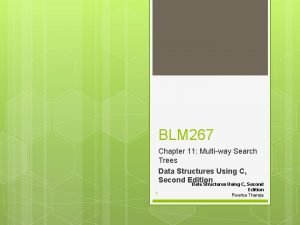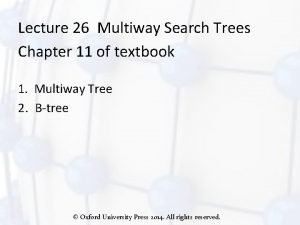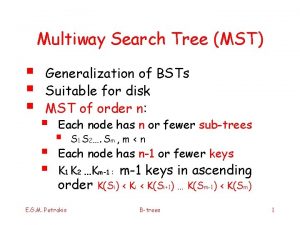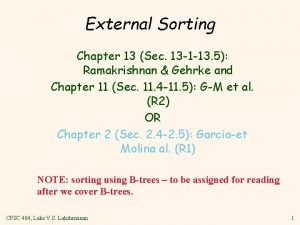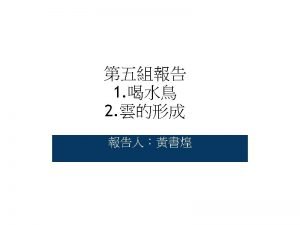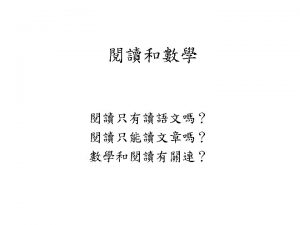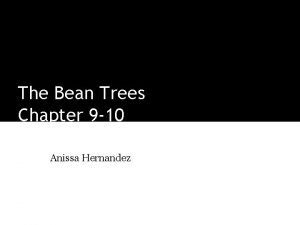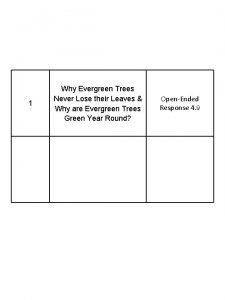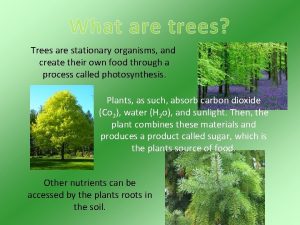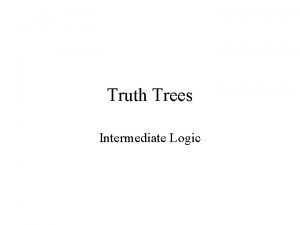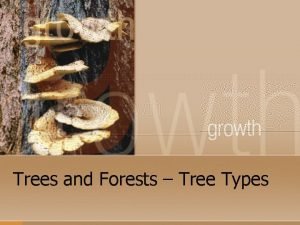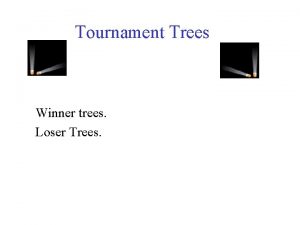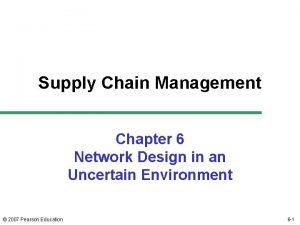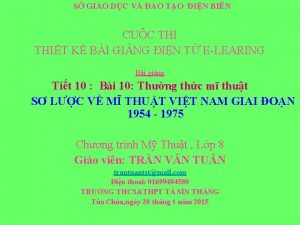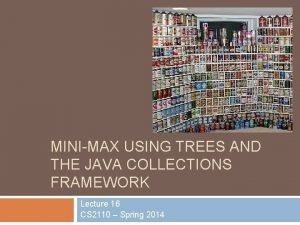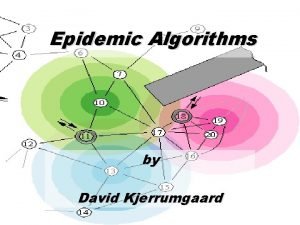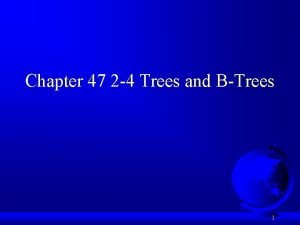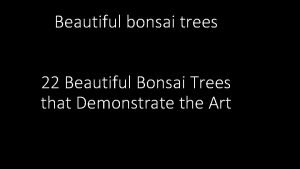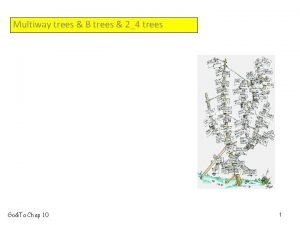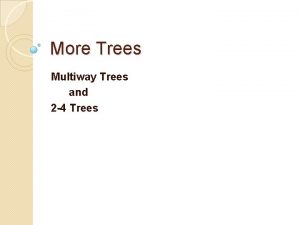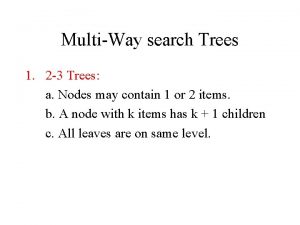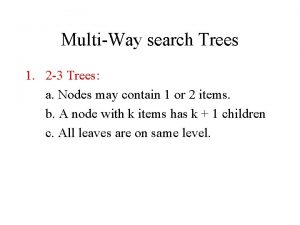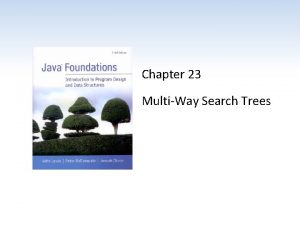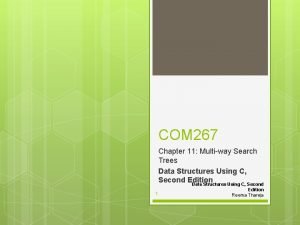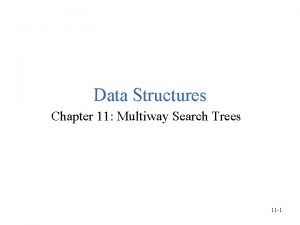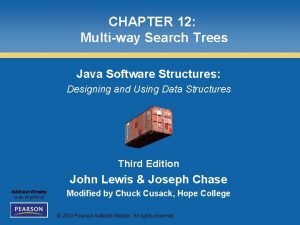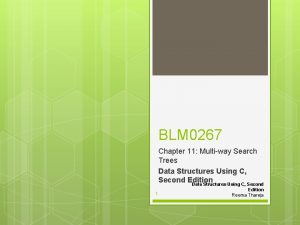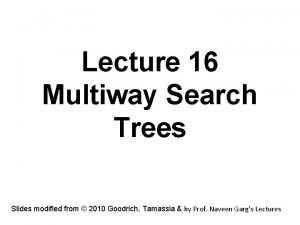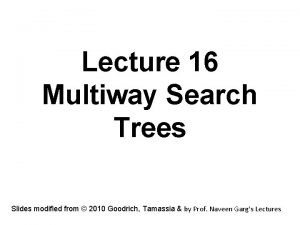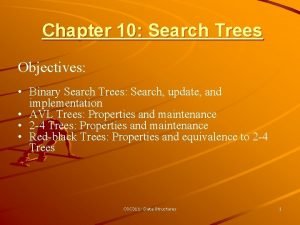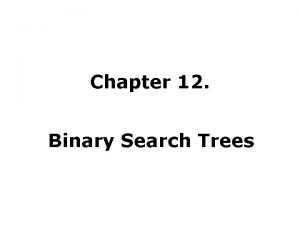Chapter 12 MultiWay search Trees 1 2 3


















































































- Slides: 82

Chapter 12 Multi-Way search Trees 1. 2 -3 Trees: a. Nodes may contain 1 or 2 items. b. A node with k items has k + 1 children c. All leaves are on same level. 1

Example • A 2 -3 tree storing 18 items. 20 80 30 70 5 2 4 10 25 40 50 75 90 100 85 95 110 120 2

Updating • Insertion: • Find the appropriate leaf. If there is only one item, just add to leaf. • Insert(23); Insert(15) • If no room, move middle item to parent and split remaining two items among two children. • Insert(3); 3

Insertion • Insert(3); 20 80 5 2 3 4 10 15 30 70 23 25 40 50 75 90 100 85 95 110 120 4

Insert(3); • In mid air… 20 80 5 30 70 90 100 3 2 4 10 15 23 25 40 50 75 85 95 110 120 5

Done…. 20 80 3 5 2 30 70 4 10 15 23 25 40 50 75 90 100 85 95 110 120 6

Tree grows at the root… • Insert(45); 20 80 3 5 2 4 30 70 10 25 40 45 50 75 90 100 85 95 110 120 7

• New root: 45 20 3 5 2 4 80 30 10 25 40 70 50 90 100 75 85 95 110 120 8

Delete • If item is not in a leaf exchange with inorder successor. • If leaf has another item, remove item. • Examples: Remove(110); • (Insert(110); Remove(100); ) • If leaf has only one item but sibling has two items: redistribute items. Remove(80); 9

Remove(80); • Step 1: Exchange 80 with in-order successor. 45 20 3 5 2 4 85 30 10 25 40 70 50 90 100 75 80 95 110 120 10

• Redistribute Remove(80); 45 20 3 5 2 4 85 30 10 25 40 70 50 95 110 75 90 100 120 11

Some more removals… • Remove(70); Swap(70, 75); Remove(70); “Merge” Empty node with sibling; Join parent with node; Now every node has k+1 children except that one node has 0 items and one child. Sibling 95 110 can spare an item: redistribute. 12

Delete(70) 45 20 3 5 2 4 85 30 10 25 40 75 50 95 110 90 100 120 13

New tree: • Delete(85) will “shrink” the tree. 45 20 3 5 2 4 95 30 10 85 25 40 50 110 90 100 120 14

Details • • • 1. Swap(85, 90) //inorder successor 2. Remove(85) //empty node created 3. Merge with sibling 4. Drop item from parent// (50, 90) empty Parent 5. Merge empty node with sibling, drop item from parent (95) • 6. Parent empty, merge with sibling drop item. Parent (root) empty, remove root. 15

“Shorter” 2 -3 Tree 20 45 3 5 2 4 30 10 25 40 95 110 50 90 100 120 16

Deletion Summary • If item k is present but not in a leaf, swap with inorder successor; • Delete item k from leaf L. • If L has no items: Fix(L); • Fix(Node N); • //All nodes have k items and k+1 children • // A node with 0 items and 1 child is possible, it will have to be fixed. 17

Deletion (continued) • If N is the root, delete it and return its child as the new root. • Example: Delete(8); 5 5 1 3 2 8 3 3 Return 35 35 18

Deletion (Continued) • If a sibling S of N has 2 items distribute items among N, S and the parent P; if N is internal, move the appropriate child from S to N. • Else bring an item from P into S; • If N is internal, make its (single) child the child of S; remove N. • If P has no items Fix(P) (recursive call) 19

(2, 4) Trees • Size Property: nodes may have 1, 2, 3 items. • Every node, except leaves has size+1 children. • Depth property: all leaves have the same depth. • Insertion: If during the search for the leaf you encounter a “full” node, split it. 20

(2, 4) Tree 10 45 3 8 25 60 50 55 70 90 100 21

Insert(38); 45 10 60 3 8 25 38 50 55 70 90 100 22

Insert(105) • Insert(105); 45 10 3 8 25 38 60 90 50 55 70 105 23

Removal • As with BS trees, we may place the node to be removed in a leaf. • If the leaf v has another item, done. • If not, we have an UNDERFLOW. • If a sibling of v has 2 or 3 items, transfer an item. • If v has 2 or 3 siblings we perform a transfer 24

Removal • If v has only one sibling with a single item we drop an item from the parent to the sibling, remove v. This may create an underflow at the parent. We “percolate” up the underflow. It may reach the root in which case the root will be discarded and the tree will “shrink”. 25

Delete(15) 35 20 6 60 15 40 50 70 80 90 26

Delete(15) 35 20 6 60 40 50 70 80 90 27

Continued • Drop item from parent 35 60 6 20 40 50 70 80 90 28

Fuse 35 60 6 20 40 50 70 80 90 29

Drop item from root • Remove root, return the child. 35 60 6 20 40 50 70 80 90 30

Summary • Both 2 -3 trees and 2 -4 trees make it very easy to maintain balance. • Insertion and deletion easier for 2 -4 tree. • Cost is waste of space in each node. Also extra comparison inside each node. • Does not “extend” binary trees. 31

Red-Black Trees • Root property: Root is BLACK. • External Property: Every external node is BLACK (external nodes: null nodes) • Internal property: Children of a RED node are BLACK. • Depth property: All external nodes have the same BLACK depth. 32

A Red. Black tree. Black depth 3. 30 15 10 70 20 85 60 5 65 80 50 40 55 90 33

Red. Black Insertion 34

Red Black Trees, Insertion 1. Find proper external node. 2. Insert and color node red. 3. No black depth violation but may violate the red-black parent-child relationship. 4. Let: z be the inserted node, v its parent and u its grandparent. If v is red then u must be black. 35

Color adjustments. • Red child, red parent. Parent has a black sibling (Zig-Zag). a b u w v z Vl Zl Zr 36

Rotation • Z-middle key. Black height does not change! No more red-red. a b z u v Vl Zl Zr w 37

Color adjustment II a b u w v Vr z Zl Zr 38

Rotation II • v-middle key a b v u z Zl Zr Vr w 39

Recoloring • Red child, red parent. Parent has a red sibling. a b u w v z Vl Zr 40

Color adjustment • Red-red may move up… a b u w v z Vl Zl Zr 41

Red Black Tree • Insert 10 – root 10 42

Red Black Tree • Insert 10 – root (external nodes not shown) 10 43

Red Black Tree • Insert 85 10 85 44

Red Black Tree • Insert 15 10 85 15 45

Red Black Tree • Rotate – Change colors 15 10 85 46

Red Black Tree • Insert 70 15 10 85 70 47

Red Black Tree • Change Color 15 10 85 70 48

Red Black Tree • Insert 20 (sibling of parent is black) 15 10 85 70 20 49

Red Black Tree • Rotate 15 10 70 20 85 50

Red Black Tree • Insert 60 (sibling of parent is red) 15 10 70 85 20 60 51

Red Black Tree • Change Color 15 10 70 85 20 60 52

Red Black Tree • Insert 30 (sibling of parent is black) 15 10 70 85 20 60 30 53

Red Black Tree • Rotate 15 10 70 85 30 20 60 54

Red Black Tree • Insert 50 (sibling ? ) 15 10 70 85 30 20 60 50 55

Red Black Tree • Insert 50 (sibling of 70 is black!) 15 gramps 15 10 70 Child 30 Oops, red-red. ROTATE! 85 30 20 Parent 70 60 50 56

Red Black Tree • Double Rotate – Adjust colors 30 15 10 Child-Parent-Gramps 70 20 60 85 50 Middle goes to “top” Previous top becomes child. Its right child is middles left child. 57

Red Black Tree • Insert 65 30 15 10 70 20 85 60 50 65 58

Red Black Tree • Insert 80 30 15 10 70 20 85 60 50 65 80 59

Red Black Tree • Insert 90 30 15 10 70 20 85 60 50 65 80 90 60

Red Black Tree • Insert 40 30 15 10 70 20 85 60 50 40 65 80 90 61

Red Black Tree • Adjust color 30 15 10 70 20 85 60 50 40 65 80 90 62

Red Black Tree • Insert 5 30 15 10 70 20 85 60 5 50 40 65 80 90 63

Red Black Tree • Insert 55 30 15 10 70 20 85 60 5 65 80 50 40 55 90 64

Delete • We first note that a red node is either a leaf or must have two children. • Also, if a black node has a single child it must be a red leaf. • Swap X with inorder successor. • If inorder successor is red, (must be a leaf) delete. If it is a single child parent, delete and change its child color to black. In both cases the resulting tree is a legit red-black tree. 65

Delete demo • Delete 30: Swap with 40 and delete red leaf. 30 15 10 70 20 85 60 5 65 80 50 40 55 90 66

40 15 10 5 70 20 85 60 65 80 50 55 90 67

Inorder successor is Black Change colors along the traverse path so that the leaf to be deleted is RED. Delete 15. 30 15 10 70 20 85 60 5 65 80 50 40 55 90 68

General strategy • As you traverse the tree to locate the inorder successor let X be the current node, T its sibling and P the parent. • Color the root red. • Retain: “the color of P is red. ” • If all children of X and T are black: • P Black, X Red, T Red 69

P X A T B Both children of X and T are black: P Black X Red, T Red 70

P X A T B If X is a leaf we are done. Recall: x is the inorder successor! 71

Even though we want to proceed with X we have a red-red violation that needs to be fixed. P T has a red child. X T C 1 A D B Zig-Zag, C 1 Middle key. C 72

Note: black depth remains unchanged! C 1 P T X A B C D 73

B will become P’s right child. No change in depth. Third case P X T C 1 A B C T middle key. D 74

T P C 1 X A B C D 75

• If both children of T are red select one of the two rotations. • If the right child of X is red make it the new parent (it is on the inorder-successor path). • If the left child of X is red: 76

Root of C is black Otherwise, continue X has a red child P X C 1 T C B E Y A B 77

P C 1 T X E Y A B C 78

30 Delete 15 15 10 70 20 85 60 5 65 80 50 40 90 55 79

60 Delete 15 30 70 15 10 50 20 40 80 55 30 70 20 10 5 50 15 90 60 Swap (15, 20) 5 85 65 40 85 65 55 80 90 80

60 Delete 15 30 70 20 10 50 15 40 85 65 55 80 90 5 Third case: (mirror image) X (15) has two black children (Nulls) Sibling has one red and one black child. 81

60 Delete 15 30 70 10 5 50 20 40 85 65 55 80 90 82
 Multiway search tree
Multiway search tree 3 way search tree
3 way search tree Multiway search tree
Multiway search tree Two way selection and multiway selection
Two way selection and multiway selection Multiway selection
Multiway selection Multiway selection flowchart
Multiway selection flowchart Multiway trie
Multiway trie Mapreduce شرح
Mapreduce شرح Two phase multiway merge sort
Two phase multiway merge sort Multiway merge join pentaho
Multiway merge join pentaho Ternary search tree java
Ternary search tree java Binary search trees
Binary search trees Which search strategy is also called as blind search?
Which search strategy is also called as blind search? Federated discovery
Federated discovery Local search vs global search
Local search vs global search Federated search vs distributed search
Federated search vs distributed search Informed search and uninformed search in ai
Informed search and uninformed search in ai Mail @ malaysia.images.search.yahoo.com
Mail @ malaysia.images.search.yahoo.com Best first search
Best first search Blind search adalah
Blind search adalah Gravity yahoo
Gravity yahoo Video search yahoo
Video search yahoo Linear search disadvantages
Linear search disadvantages Linear search vs binary search
Linear search vs binary search Tw yahoo mail
Tw yahoo mail Cognitive search engine
Cognitive search engine Which search strategy is called as blind search
Which search strategy is called as blind search Yahoo shopping tw
Yahoo shopping tw Bean trees chapter 9 summary
Bean trees chapter 9 summary Type of tree that never loses leaves
Type of tree that never loses leaves Destiny 2 a futile search
Destiny 2 a futile search Chapter 13 job search skills
Chapter 13 job search skills Chapter 14 section 1 the search for spices
Chapter 14 section 1 the search for spices A crate is being lifted into a truck
A crate is being lifted into a truck What are trees
What are trees Pine tree dichotomous key
Pine tree dichotomous key Why monkeys live in trees
Why monkeys live in trees Truth table method
Truth table method Tree by joyce kilmer
Tree by joyce kilmer Coniferious trees
Coniferious trees Venn diagram of coniferous and deciduous trees
Venn diagram of coniferous and deciduous trees Frequency trees worksheet
Frequency trees worksheet Winner tree
Winner tree The trees” by philip larkin
The trees” by philip larkin Philip larkin trees
Philip larkin trees Larkin the trees
Larkin the trees Forest plants
Forest plants The tale of three trees slideshow
The tale of three trees slideshow Tree sounds
Tree sounds Most beautiful bonsai trees
Most beautiful bonsai trees The great gatsby chapter 4 summary
The great gatsby chapter 4 summary Taiga plants
Taiga plants Define coniferous forest
Define coniferous forest Supply chain network design decisions
Supply chain network design decisions Song of the trees answer key
Song of the trees answer key Selection trees
Selection trees Tác phẩm con đọc bầm nghe
Tác phẩm con đọc bầm nghe Philip larkin the trees
Philip larkin the trees Personification with the sun
Personification with the sun Palm trees in scotland
Palm trees in scotland Java collections tree
Java collections tree River biotic factors
River biotic factors Ll game
Ll game Two ordinary fair dice are rolled complete the tree diagram
Two ordinary fair dice are rolled complete the tree diagram Larkin trees
Larkin trees Summer personification examples
Summer personification examples Epidemic broadcast trees
Epidemic broadcast trees An example of a parallel choice on a dichotomous key is .
An example of a parallel choice on a dichotomous key is . Decision making trees
Decision making trees Classification and regression trees (cart)
Classification and regression trees (cart) Taxonomy pogil
Taxonomy pogil B tree animation
B tree animation Chapter 11 forestry and resource management
Chapter 11 forestry and resource management The sound of trees robert frost analysis
The sound of trees robert frost analysis An abiotic factor
An abiotic factor A leafy roof formed by tall trees.
A leafy roof formed by tall trees. A leafy roof formed by tall trees
A leafy roof formed by tall trees 50 year old bonsai tree
50 year old bonsai tree A food chain contains oak trees
A food chain contains oak trees Ephesians 6:12 tpt
Ephesians 6:12 tpt Four skinny trees answers
Four skinny trees answers Tournament trees
Tournament trees What is a threaded binary tree?
What is a threaded binary tree?
